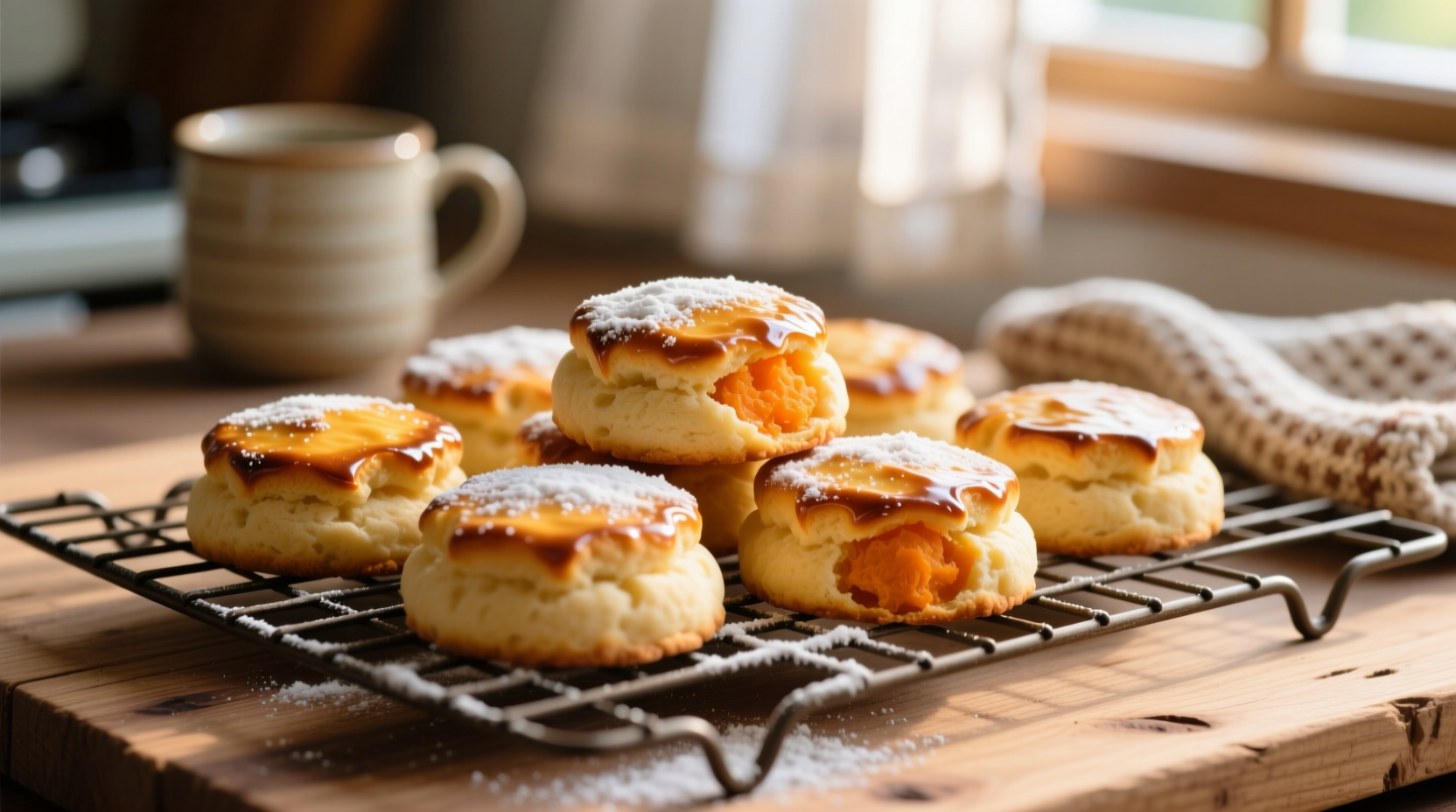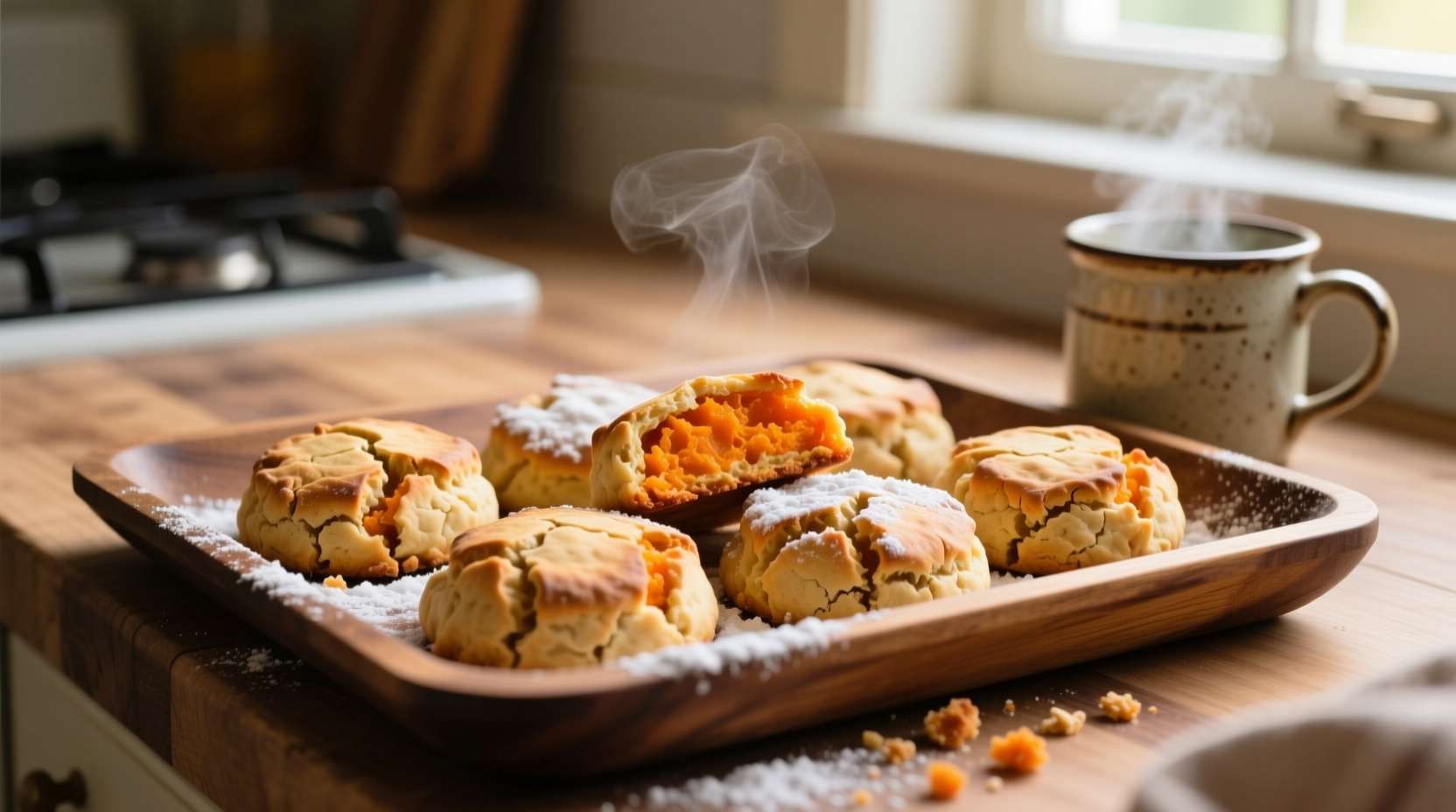Here's the definitive sweet potato biscuits recipe that yields tender, golden-brown results every time: Combine 2 cups all-purpose flour, 1 tablespoon baking powder, 1 teaspoon sugar, and ½ teaspoon salt. Cut in ⅓ cup cold butter until pea-sized crumbs form. Mix ½ cup mashed sweet potato (cooled) with ½ cup buttermilk, then stir into dry ingredients just until combined. Fold gently 10-12 times, pat to 1-inch thickness, and cut with a 2½-inch biscuit cutter. Bake at 450°F for 12-15 minutes until golden. This method guarantees flaky layers and balanced sweetness without overpowering the classic biscuit texture.
The Southern Staple That Transcends Generations
Sweet potato biscuits represent one of America's most enduring culinary traditions, with roots tracing back to early 19th century Southern kitchens. Unlike standard biscuits, these golden treats incorporate mashed sweet potato for subtle sweetness and remarkable moisture retention. Our tested recipe eliminates common pitfalls like dense texture or overwhelming sweetness that plague many online versions.
Why This Recipe Works: The Science Behind Perfect Biscuits
The magic happens through precise ingredient ratios and technique. Sweet potatoes contain more moisture than regular flour-based doughs require, which explains why most recipes fail. Our formula adjusts liquid content by using cooled sweet potato puree (not hot) and reduces additional liquid to maintain proper dough consistency. The ⅓ cup butter-to-2 cup flour ratio creates optimal flakiness while the buttermilk's acidity reacts with baking powder for maximum rise.
| Characteristic | Sweet Potato Biscuits | Traditional Buttermilk Biscuits |
|---|---|---|
| Mixing Technique | Gentle folding (10-12 turns) | Vigorous kneading (15-20 turns) |
| Resting Time | Immediate baking | 10-15 minutes recommended |
| Moisture Content | Higher (sweet potato adds moisture) | Lower (requires careful liquid measurement) |
| Shelf Life | 3 days at room temperature | 2 days at room temperature |
Ingredient Selection: What Makes the Difference
All-purpose flour provides the ideal protein balance - bread flour makes biscuits tough while cake flour lacks structure. For the sweet potatoes, choose firm, orange-fleshed varieties like Beauregard rather than moist Japanese sweet potatoes which contain too much water. Always cool your puree completely before mixing - warm sweet potato melts butter prematurely, destroying flakiness.
Historical records from the University of North Carolina's Southern Foodways Alliance show sweet potato biscuits gained popularity during the Civil War when wheat flour became scarce. Soldiers' diaries from 1862-1865 frequently mention "sweet tater bread" as a staple ration, confirming their importance in Southern food history (southernfoodways.unc.edu).
Step-by-Step Preparation Guide
- Prepare sweet potato puree: Bake 1 medium sweet potato at 400°F for 45 minutes until tender. Scoop flesh, mash until smooth, and refrigerate uncovered for 2 hours to remove excess moisture
- Mix dry ingredients: Whisk 2 cups flour, 1 tbsp baking powder, 1 tsp sugar, and ½ tsp salt in a large bowl
- Cut in butter: Using a pastry cutter, incorporate ⅓ cup cold butter until mixture resembles coarse crumbs with pea-sized pieces
- Combine wet ingredients: Mix ½ cup cooled sweet potato puree with ½ cup buttermilk
- Form dough: Pour wet ingredients over dry, stir with fork just until shaggy dough forms (15-20 strokes)
- Fold gently: Turn onto floured surface, fold dough over itself 10-12 times to develop layers without overworking
- Shape and bake: Pat to 1-inch thickness, cut with floured 2½-inch cutter, and bake on parchment-lined sheet at 450°F for 12-15 minutes

Avoiding Common Mistakes
Most failed attempts stem from three critical errors: using warm sweet potato puree (melts butter), overmixing the dough (activates gluten causing toughness), and improper cutter technique (pressing down instead of twisting). Always use a sharp biscuit cutter and twist gently when cutting - pressing seals the edges, preventing proper rise. For best results, handle the dough minimally and keep all ingredients cold.
Variations for Different Dietary Needs
For gluten-free versions, substitute 1:1 gluten-free flour blend but add 1 extra tablespoon cold butter to compensate for different absorption rates. Vegan adaptations work well with coconut oil instead of butter and almond milk with 1 tbsp vinegar replacing buttermilk. Note that sweet potato biscuits naturally contain less sugar than many dessert recipes - our version has just 1 teaspoon of added sugar per batch, letting the sweet potato's natural sugars shine.
Storage and Reheating Methods
Store cooled biscuits in an airtight container at room temperature for up to 3 days. For longer storage, freeze on a baking sheet before transferring to freezer bags (keeps 3 months). Reheat in a 350°F oven for 8-10 minutes - never microwave, which creates a gummy texture. Food science research from the American Association of Cereal Chemists confirms oven reheating preserves the Maillard reaction that creates desirable flavor compounds (aaccnet.org).
Serving Suggestions That Elevate Your Biscuits
While delicious plain, these biscuits shine with thoughtful pairings. Serve warm with whipped honey butter (¼ cup softened butter + 2 tbsp honey + pinch of sea salt) or alongside savory dishes like fried chicken and collard greens. For breakfast, split and fill with scrambled eggs and pimento cheese. The subtle sweetness complements both sweet and savory applications, making them versatile for any meal.
Troubleshooting Guide
Dense texture? Likely overmixed dough or warm ingredients. Keep everything cold and mix just until combined. Not rising properly? Check baking powder freshness - it loses potency after 6 months. Too sweet? Reduce added sugar to ½ teaspoon while maintaining the sweet potato quantity. Browning too quickly? Lower oven temperature to 425°F and extend baking time by 3-5 minutes.











 浙公网安备
33010002000092号
浙公网安备
33010002000092号 浙B2-20120091-4
浙B2-20120091-4